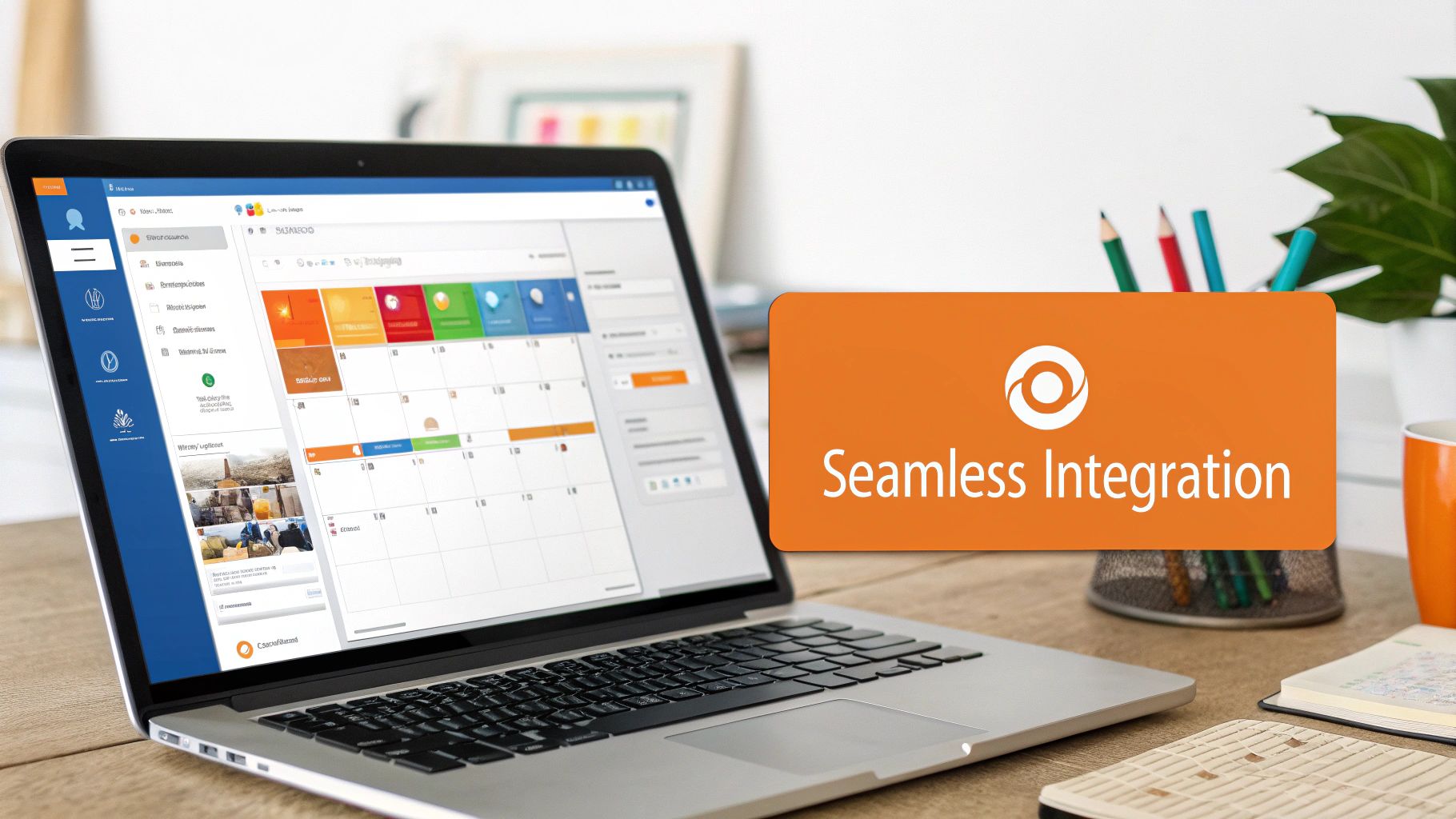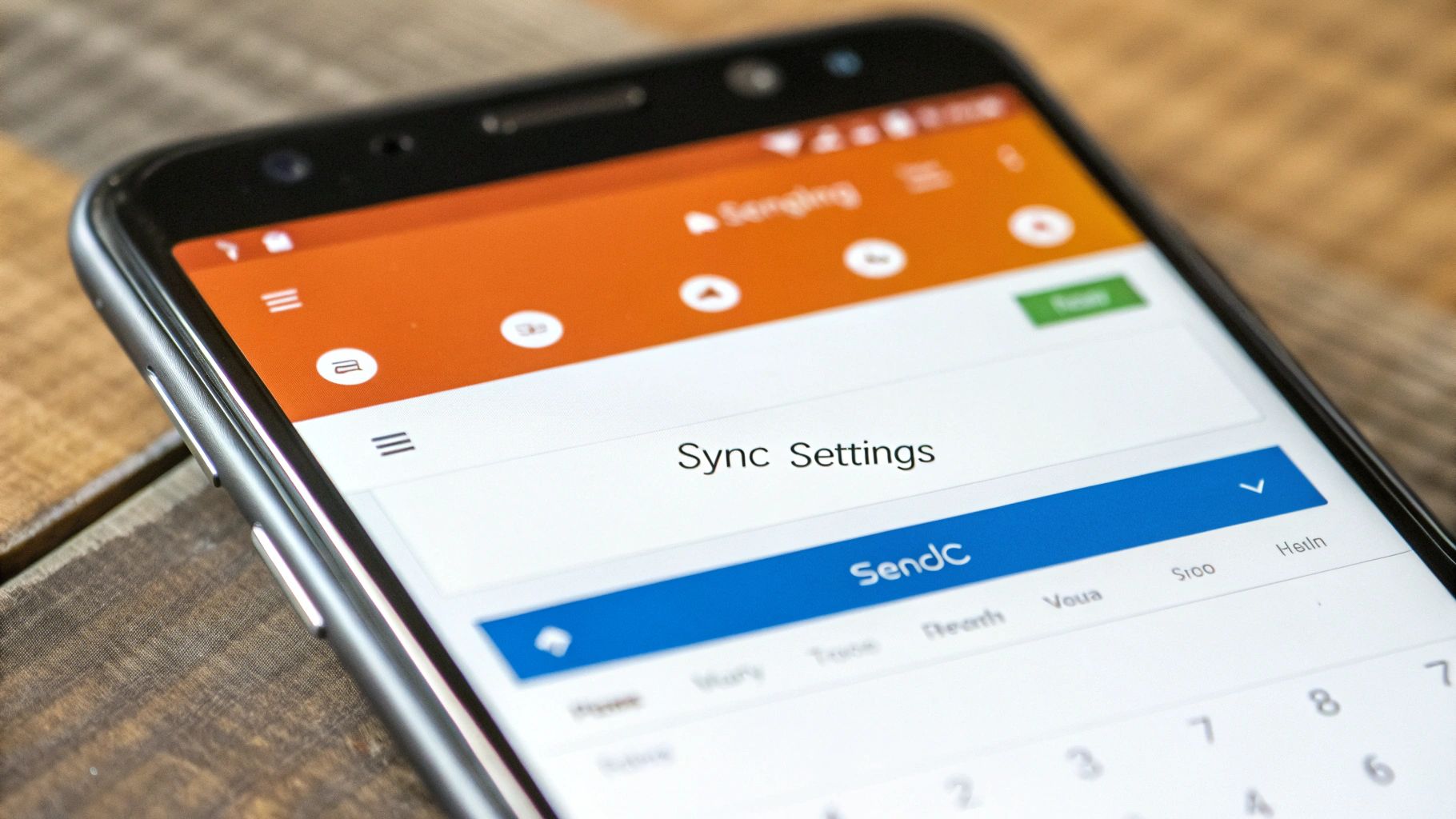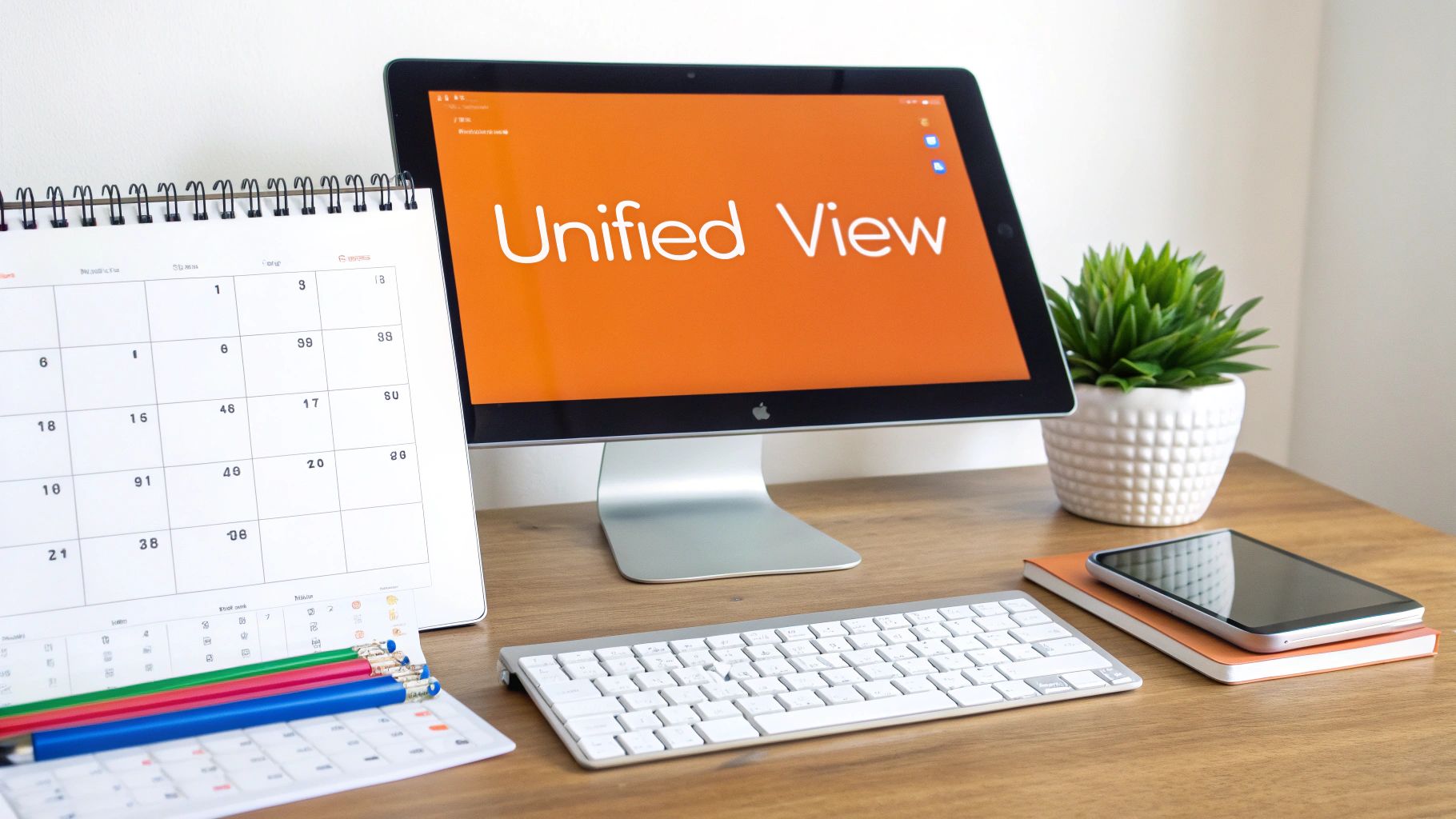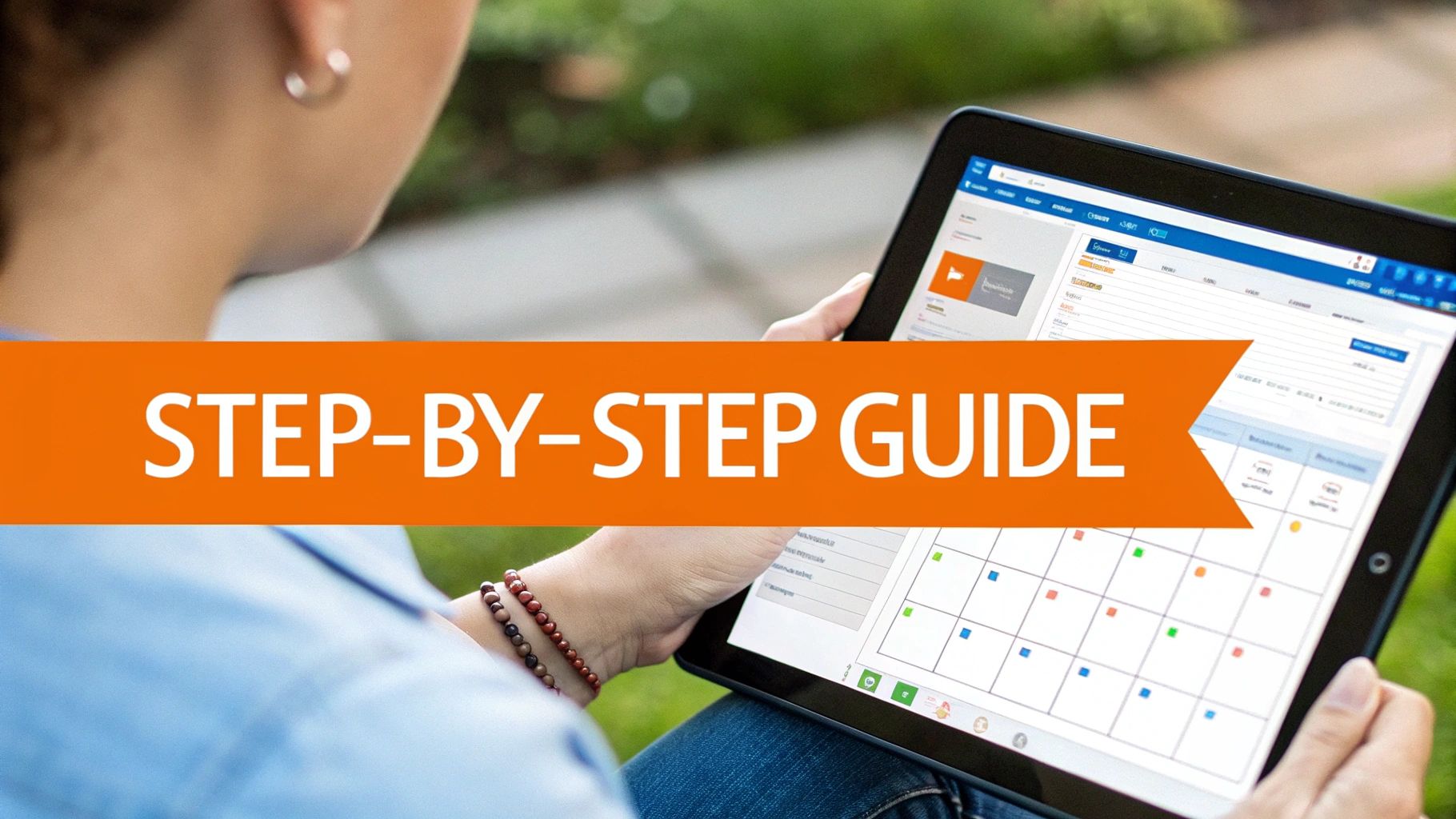Understanding Calendar Integration Essentials

Managing multiple calendars can be overwhelming and confusing. A simple scheduling mistake like double-booking or missing a meeting disrupts your entire day. That's why calendar synchronization - keeping your calendars in sync with the same information - is crucial for staying organized.
Take a freelancer who needs to track client meetings, personal appointments, and project deadlines. By syncing their Microsoft Outlook work calendar with their personal Google Calendar, they can smoothly manage their schedule in one place.
Why Sync Matters
Calendar syncing delivers clear benefits for busy professionals. You get a complete view of your schedule in one place, making it easier to plan your time. Teams stay coordinated since everyone can see the latest meeting updates. No more wasting time checking multiple calendars or making scheduling mistakes.
For those using both Google and Outlook calendars, Google Workspace Sync for Microsoft Outlook (GWSMO) helps sync emails, calendars and contacts between the two platforms. This tool keeps your work and personal calendars perfectly aligned.
How Different Sync Approaches Impact Workflow
Calendar syncing comes in a few key varieties. Real-time, two-way synchronization means changes instantly appear across all your calendars. One-way imports only update in a single direction at set times. For example, a sales team needs instant syncing to coordinate client meetings, while a personal calendar might only need occasional updates from your work schedule.
Choosing the Right Sync Method
Pick a sync method that matches your calendar habits. Consider:
- How often you update your calendars
- The number of calendars you manage
- Your tech comfort level
More advanced sync options give you greater control but require more setup. Basic sync methods are simpler but may have limitations. Your specific needs should guide which approach works best for staying organized.
Choosing Your Perfect Sync Solution

Calendar syncing helps busy professionals keep their schedules organized and their teams coordinated. The key is picking the right sync approach for your workflow and comfort level. Let's look at some popular ways to connect your Google Calendar with Outlook.
Common Ways to Sync Your Calendars
One simple option is using the built-in calendar sharing features to import calendars between platforms. While easy to set up, updates may take some time to show up. Want to learn about more sync methods? Check out our in-depth guide on syncing Outlook and Google calendars.
SyncThemCalendars and other calendar sync tools give you more control with features like two-way sync and the ability to choose which events to share. This works well when managing multiple calendars or keeping work and personal schedules separate.
For those comfortable with technical setup, API integration provides instant syncing between calendars. While it requires more configuration, it offers seamless real-time updates.
What to Look for in a Sync Solution
Here are the key factors to consider when choosing how to sync:
- Update Speed: Do you need instant updates for team coordination, or is periodic syncing enough?
- Sync Direction: One-way sync is simpler but limited. Two-way sync ensures both calendars stay current.
- User-Friendliness: Pick a method that matches your comfort level with software setup and troubleshooting.
- Capabilities: Consider whether you need extra features like selective syncing or multiple calendar support.
- Price: While some tools are free, others require paid subscriptions. Weigh the features against the cost.
Comparing Sync Methods
Here's a quick look at how different sync approaches stack up:
Sync MethodReal-time SyncSetup DifficultyBest ForCalendar Sharing/ImportingOften DelayedEasyBasic individual useThird-Party Apps (e.g., SyncThemCalendars)Usually Real-TimeEasy to ModerateFeature-focused usersAPI IntegrationReal-TimeModerate to HardTechnical users
By evaluating these options based on your needs, you can find the right sync solution to keep your schedules in perfect harmony. The next section will show you how to set up your chosen method step by step.
Setting Up Your Calendar Sync Like a Pro

Ready to get your calendars working together? Let's walk through setting up the sync between Google Calendar and Outlook. We'll share practical tips from IT pros to help make the process smooth and successful.
Syncing with SyncThemCalendars
SyncThemCalendars makes it easy to sync your calendars while keeping full control over your information. Here's how to set it up:
- Create an Account: Sign up at syncthemcalendars.com
- Link Your Calendars: Give permission for SyncThemCalendars to connect to both Google Calendar and Outlook
- Choose Your Settings: Pick which calendars to sync and whether you want one-way or two-way syncing between them
- Customize Event Details: Adjust how events display in each calendar - perfect for keeping client meetings private or organizing different projects
- Start Syncing: Hit activate and watch your calendars start working together
Verifying Your Sync
Take a few minutes to check that everything synced properly. Look at both calendars to make sure recent events copied over correctly. Try updating an event time in one calendar and confirm the change shows up in the other. This quick test ensures your calendars are talking to each other the way you want.
Troubleshooting Tips
Running into minor issues? Here are some quick fixes:
- Check Your Internet: Make sure you have a stable connection
- Review Settings: Double-check your sync options in SyncThemCalendars
- Reconnect Accounts: If needed, try disconnecting and reconnecting your calendar accounts
With these steps, you'll have your calendars syncing perfectly and working together to keep your schedule organized. The right setup lets you focus on your work instead of juggling multiple calendars manually.
Mastering Calendar Sync Troubleshooting

Sometimes calendar syncing doesn't go as planned, even with careful setup. Let's explore how to quickly spot and fix common sync issues between Google Calendar and Outlook to keep your schedules properly aligned.
Reliable calendar sync is crucial for effective scheduling. A sync error leading to a missed meeting can throw off your whole day and strain work relationships. That's why it's so important to know how to troubleshoot sync problems when they arise. Learn more about handling sync issues at Virto Software.
Common Sync Problems and Solutions
Several factors can interfere with smooth calendar syncing. Internet connection problems often cause sync failures by preventing updates from going through. Wrong settings in SyncThemCalendars like incorrect sync direction or calendar selection can also create scheduling mix-ups.
Here's how to tackle typical syncing problems:
- Missing Events: Start by checking your internet. Then verify your SyncThemCalendars sync settings are correct - confirm you selected the right calendars and sync direction. Try disconnecting and reconnecting your calendar accounts if needed.
- Duplicate Events: This usually means you have multiple sync methods running. Check your connected accounts in both SyncThemCalendars and your calendar apps to find and remove any extra connections.
- Wrong Event Details: First make sure the original event info is right. Then check that your SyncThemCalendars settings allow proper transfer of event details. Sometimes a sync refresh will fix detail problems.
Preventative Measures and Best Practices
It's smart to prevent sync problems before they start. Check your SyncThemCalendars settings regularly, especially after making calendar changes. Stay on top of SyncThemCalendars updates to get the latest fixes and improvements.
Key tips to prevent sync issues:
- Review Settings Often: Make sure your SyncThemCalendars setup still matches how you use your calendars.
- Update Software: Keep SyncThemCalendars current for best performance.
- Watch Sync Status: Pay attention to error messages and fix small problems quickly before they grow.
Following these troubleshooting tips and taking preventive steps will help keep your Google Calendar and Outlook smoothly synced so you can schedule with peace of mind.
Calendar Management Secrets Revealed
Good calendar management turns your synced Google and Outlook calendars into effective scheduling tools. Let's explore proven strategies to get the most from your synchronized calendars.
Structuring Your Calendars for Optimal Visibility
Think of your calendar as a visual dashboard for your time. A messy calendar makes planning difficult, so focus on clear organization from the start.
- Color-Coding: Give different types of events their own colors (e.g., blue for work, green for personal, orange for family) to quickly spot what's what at a glance
- Time Blocking: Reserve specific chunks of time for focused work, meetings, and personal activities to prevent overscheduling and maintain balance
These visual elements help you understand your schedule instantly, reducing time spent searching for information.
Smart Categorization and Automation
Strategic categorization and automation make calendar management much simpler. Set up rules to handle incoming appointments automatically and keep everything organized.
- Clear Naming Conventions: Add keywords to event titles for easy filtering (e.g., start client meetings with "Client -" to find them quickly)
- Built-in Calendar Features: Use recurring appointments and automated reminders to stay on top of deadlines without constant manual tracking
These approaches streamline your workflow and free up mental space for more important tasks.
Maximizing Efficiency with Advanced Techniques
Here are some expert-level calendar management strategies that can take your productivity to the next level:
PracticeBenefitImplementation DifficultySetting Default DurationsReduces back-and-forth emails when schedulingEasyUsing Keyboard ShortcutsMakes calendar navigation fasterModerateIntegrating Task ToolsCombines schedule and to-do list managementModerate
These power user techniques help you get the most from your synced calendars. Even implementing just a few of these strategies will help you master calendar syncing between Google Calendar and Outlook while managing your time more effectively. Better calendar management leads directly to improved productivity and less stress about scheduling.
Power User Tips and Advanced Features
Looking to get more out of your calendar sync setup? Let's explore some proven techniques used by productivity experts to make the most of your calendar management.
Customizing Sync Rules for Granular Control
SyncThemCalendars offers advanced settings that give you precise control over how your calendars interact. This helps you manage multiple calendars while maintaining privacy for sensitive information.
- Selective Syncing: Pick which calendars or individual events to sync, keeping work and personal appointments separate. Perfect for managing multiple clients or different business ventures.
- Event Modification: Adjust how event details appear across calendars. For example, hide client details in your personal calendar while keeping full visibility in your work calendar.
These customization options let you set up calendar syncing that perfectly matches your needs.
Automating Your Workflow with Advanced Settings
Save time by automating repetitive calendar tasks. These features help you avoid manual updates and simplify calendar management.
- Automated Category Assignment: Create rules to automatically tag synced events with categories, making organization easier. For example, any event marked "Meeting" can automatically go into your "Work" category.
- Custom Reminders: Set different reminder times for each calendar type. You might want longer notice for client meetings versus personal appointments.
By automating these routine tasks, you'll free up mental space for more important work.
Time-Blocking Strategies for Peak Productivity
Time-blocking is a favorite technique among high performers to reserve specific time slots for key activities. When combined with synced calendars, it creates an effective system for managing your schedule.
- Dedicated Focus Time: Reserve blocks specifically for focused work, helping you maintain concentration without interruption. This ensures your most important projects get proper attention.
- Strategic Meeting Scheduling: Group meetings together to maintain larger chunks of uninterrupted work time. This approach reduces task-switching and helps maintain productivity.
Using these time-blocking methods with your synced calendars helps create a more organized and effective schedule.
Ready to upgrade your calendar management? Sign up for SyncThemCalendars today and experience seamless calendar syncing.


